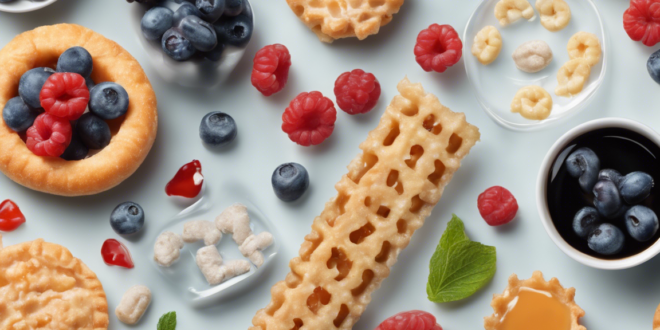Low-Sugar Snacks for Healthy Living: Supercharge Your Diet with Nutrient-Dense Superfoods
In today’s fast-paced world, maintaining a healthy diet can be challenging. Many Americans struggle with high-sugar snacks that provide little nutritional value and can lead to energy crashes and long-term health issues. This comprehensive guide will walk you through incorporating superfoods into your daily meals, helping you create delicious, low-sugar snacks that nourish your body and support overall wellness.
Understanding Superfoods: Nature’s Nutritional Powerhouses
Superfoods are nutrient-rich ingredients packed with vitamins, minerals, antioxidants, and other essential compounds that provide exceptional health benefits. Unlike processed snacks loaded with sugar and empty calories, these natural powerhouses can help boost energy, support immune function, and promote long-term health.
Top Superfoods to Transform Your Snacking Habits
1. Chia Seeds: These tiny seeds are nutritional giants, offering a remarkable blend of protein, fiber, and omega-3 fatty acids. Just two tablespoons contain approximately 4 grams of protein and 11 grams of fiber, making them an excellent low-sugar snack option.
2. Almonds: Rich in healthy fats, protein, and essential minerals, almonds provide a satisfying crunch while supporting heart health and maintaining stable blood sugar levels. A quarter-cup serving contains 7 grams of protein and only 1 gram of sugar.
3. Berries: Packed with antioxidants and low in sugar, berries like blueberries, strawberries, and raspberries offer a sweet taste without the metabolic drawbacks of traditional sugary snacks. One cup of mixed berries contains only about 7 grams of natural sugar.
Step-by-Step Guide to Incorporating Superfoods into Your Diet
Step 1: Meal Preparation and Planning
Successful superfood integration begins with strategic meal planning. Start by dedicating time each week to prepare nutrient-dense snacks and meals. Invest in quality storage containers and create a consistent schedule for meal prep to ensure you always have healthy options available.
Step 2: Creating Balanced Superfood Snacks
Balance is key when designing superfood snacks. Combine different nutrient sources to create satisfying and nutritionally complete options. For example, pair chia seeds with Greek yogurt or mix almonds with fresh berries for a protein-rich, low-sugar treat.
Superfood Snack Recipes to Get You Started
Chia Seed Pudding
Ingredients:
– 3 tablespoons chia seeds
– 1 cup unsweetened almond milk
– 1/2 teaspoon vanilla extract
– Fresh berries for topping
– Optional: Stevia or monk fruit sweetener
Instructions:
1. Mix chia seeds with almond milk and vanilla
2. Refrigerate overnight
3. Top with fresh berries before serving
Almond and Berry Energy Balls
Ingredients:
– 1 cup raw almonds
– 1/2 cup dried blueberries
– 2 tablespoons chia seeds
– 4-5 dates, pitted
– 1 tablespoon coconut oil
Instructions:
1. Blend all ingredients in a food processor
2. Roll into small balls
3. Refrigerate for 30 minutes before serving
Nutritional Strategies for Long-Term Success
Transitioning to a superfood-rich diet requires patience and consistency. Start by gradually replacing high-sugar snacks with nutrient-dense alternatives. Listen to your body and pay attention to how different foods make you feel.
Monitoring Your Progress
Consider tracking your nutrition using mobile apps or a food diary. Monitor your energy levels, sleep quality, and overall well-being as you incorporate more superfoods into your diet. Regular blood work can also help assess the impact of dietary changes.
Budget-Friendly Superfood Shopping Tips
Contrary to popular belief, eating superfoods doesn’t have to be expensive. Buy in bulk, choose seasonal produce, and look for sales at local grocery stores and farmers markets. Frozen berries and bulk nuts can be cost-effective alternatives to fresh options.
Potential Challenges and Solutions
Some individuals might experience digestive changes when first introducing superfoods. Start with small quantities and gradually increase intake. Stay hydrated and consider consulting a nutritionist if you have specific dietary concerns or health conditions.
Conclusion: Your Path to Healthier Snacking
Incorporating superfoods into your diet is a powerful strategy for improving overall health and reducing sugar intake. By making informed choices and experimenting with nutrient-rich ingredients, you can transform your snacking habits and support long-term wellness.
Remember, sustainable health is a journey, not a destination. Embrace the process, be patient with yourself, and enjoy discovering delicious, nutritious alternatives to high-sugar snacks.
 Good Calories Guide GoodCalories Guide focuses on nutrition, healthy eating, and overall wellness. The site offers practical insights into evidence-based dietary practices, including tips for specific lifestyles such as veganism, keto, and family-friendly meal planning. It also addresses unique nutritional needs for individuals with conditions like diabetes or food allergies, while providing quick and accessible recipes to make healthy living a sustainable and enjoyable choice.
Good Calories Guide GoodCalories Guide focuses on nutrition, healthy eating, and overall wellness. The site offers practical insights into evidence-based dietary practices, including tips for specific lifestyles such as veganism, keto, and family-friendly meal planning. It also addresses unique nutritional needs for individuals with conditions like diabetes or food allergies, while providing quick and accessible recipes to make healthy living a sustainable and enjoyable choice.


